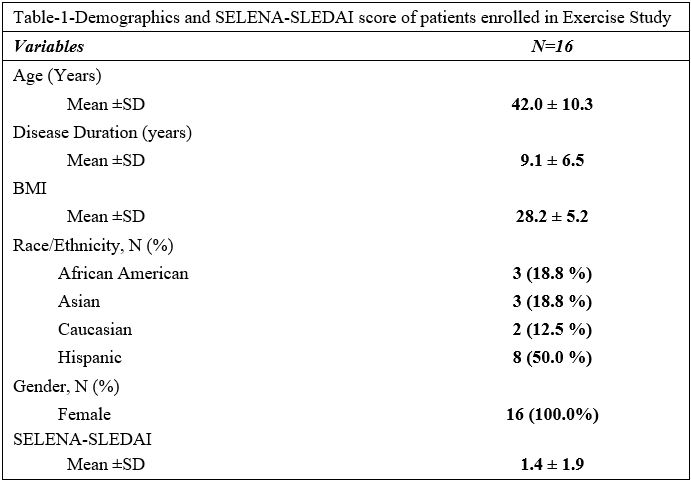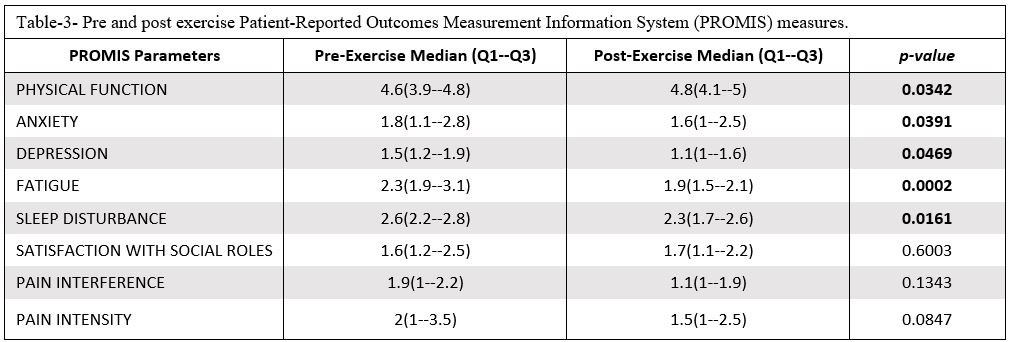Session Information
Date: Monday, November 9, 2020
Title: SLE – Treatment Poster II
Session Type: Poster Session D
Session Time: 9:00AM-11:00AM
Background/Purpose: Systemic lupus erythematosus (SLE) is a chronic systemic autoimmune disease of female predominance. One of the most debilitating symptoms experienced by SLE-patients is persistent fatigue. Prior research from our group suggests that fatigue, as measured by the Fatigue Severity Scale (FSS), is independent of SLE disease activity, as measured by Safety of Estrogen in Lupus Erythematosus National Assessment Group-Systemic Lupus Erythematosus Disease Activity Index (SELENA-SLEDAI) scores. Mitochondrial dysfunction and the type I Interferon pathway may contribute to fatigue in SLE. The purpose of this study is to characterize the responses and adaptations to a program of aerobic exercise in SLE patients with significant fatigue and minimal disease activity. Here we present preliminary analysis of our study.
Methods: A cohort of 20 SLE patients with minimal disease activity (SELENA-SLEDAI < 4) and self-reported presence of fatigue (FSS > 3) are being enrolled in an open label monitored, aerobic exercise intervention program. The exercise program consists of treadmill exercise for 30 minutes, three times a week for 12 weeks. Vascular endothelial dysfunction and arterial stiffness are measured by performing non-invasive vascular studies. The primary outcome measure of this study is the time it takes the subjects to reach their anaerobic threshold during a cardiopulmonary exercise test (CPET), which is performed before and after the exercise program. Secondary outcome measures such as the FSS, SELENA-SLEDAI scores and the Patient-Reported Outcomes Measurement Information System (PROMIS) survey assesses disease activity and fatigue. Other outcomes such as distance walked during a 10-minute walk test and peak O2 consumption during a CPET assesses changes in physical capacity and function. Furthermore, mechanistic studies are planned to measure mitochondrial dysfunction and interferon gene signature.
Results: To date, 16 SLE patients have completed the protocol. The average age of recruited SLE patients was 42 ± 10.3 years and the average disease duration was 9.1 ± 6.5 years (Table 1). 50% of the patients were Hispanic, 18.8% were African- American and Asian, and 12.5% were Caucasian. The average SLEDAI score at baseline was 1.4 ± 1.9, which remained constant throughout the study. The median FSS score at baseline was 4.6 (3–6.3), which decreased to 2.9 (1.2–5.9) by the end of the study (p< 0.0001) (Table 2). The PROMIS survey demonstrated an improvement across most of the parameters at the end of the study, when compared to baseline (Table 3).
Conclusion: In this preliminary analysis, patients reported a significant improvement in their fatigue and overall health following participation in an exercise program. There was no increase of SLE disease activity. The data produced from this study will provide an understanding of the mechanisms leading to fatigue in SLE patients, and the potential role of exercise in mediating these improvements. These findings will be utilized in the planning of a larger randomized controlled study to address pathophysiology of fatigue in SLE patients and recommendations for exercise interventions to modulate this disease manifestation
To cite this abstract in AMA style:
Chapman M, Gupta S, Chu J, Naqi M, Manna Z, Mazhar M, Munday A, Stockman M, Ahmad A, McCrossin G, Drinkard B, Chin L, Kaplan M, Keyser R, Chan L, Hasni S. Aerobic Exercise Improves Fatigue and Quality of Life in Women with Systemic Lupus Erythematosus (Preliminary Analysis) [abstract]. Arthritis Rheumatol. 2020; 72 (suppl 10). https://acrabstracts.org/abstract/aerobic-exercise-improves-fatigue-and-quality-of-life-in-women-with-systemic-lupus-erythematosus-preliminary-analysis/. Accessed .« Back to ACR Convergence 2020
ACR Meeting Abstracts - https://acrabstracts.org/abstract/aerobic-exercise-improves-fatigue-and-quality-of-life-in-women-with-systemic-lupus-erythematosus-preliminary-analysis/



